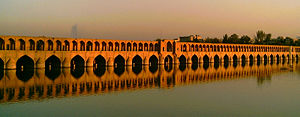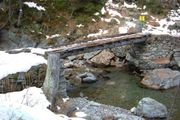Bridges
A bridge is a structure built to span a gorge, valley, road, railroad track, river, body of water, or any other physical obstacle, for the purpose of providing passage over the obstacle. more...
Designs of bridges will vary depending on the function of the bridge and the nature of the terrain where the bridge is to be constructed.
History
The first bridges were made by nature — as simple as a log fallen across a stream. The first bridges made by humans were probably spans of wooden logs or planks and eventually stones, using a simple support and crossbeam arrangement. Most of these early bridges could not support heavy weights or withstand strong currents. It was these inadequacies which led to the development of better bridges.
Epic literature of India provides mythological accounts of bridges constructed from India to Lanka by the army of Rama. The Arthashastra of Kautilya mentions the construction of dams and bridges. A Mauryan bridge near Girnar was surveyed by James Princep. The bridge was swept away during a flood, and later repaired by Puspagupta, the chief architect of emperor Chandragupta I. The bridge also fell under the care of the Yavana Tushaspa, and the Satrap Rudra Daman. The use of stronger bridges using plaited bamboo and iron chain was visible in India by about the 4th century. A number of bridges, both for military and commercial purposes, were constructed by the Mughal administration in India.
The ancient Romans built arch bridges and aqueducts that could stand in conditions that would damage or destroy earlier designs. Some of them still stand today. An example is the Alcántara Bridge, built over the river Tagus, in Spain. Most earlier bridges would have been swept away by the strong current. The Romans also used cement, which reduced the variation of strength found in natural stone. One type of cement, called pozzolana, consisted of water, lime, sand, and volcanic rock. Brick and mortar bridges were built after the Roman era, as the technology for cement was lost then later rediscovered.
Although large Chinese bridges of wooden construction existed at the time of the Warring States, the oldest surviving stone bridge in China is the Zhaozhou Bridge, built from 595 to 605 AD during the Sui Dynasty. This bridge is also historically significant as it is the world's oldest open-spandrel stone segmental arch bridge. European segmental arch bridges date back to at least the Alconétar Bridge (approximately 2nd century AD), while the enormous Roman era Trajan's Bridge (105 AD) featured open-spandrel segmental arches in wooden construction.
Read more at Wikipedia.org



